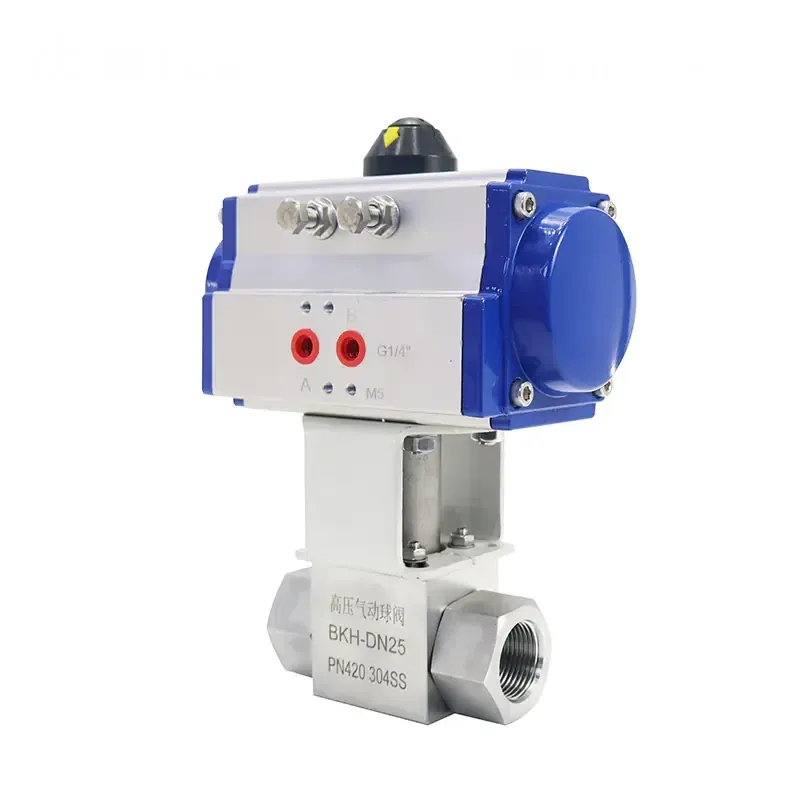
In industrial fluid control systems, high-pressure ball control valves play a crucial role in managing the flow and pressure of liquids and gases. These valves are designed to withstand extreme pressure conditions while ensuring precision, durability, and leak-free operation. Their versatility makes them indispensable in industries such as oil and gas, petrochemicals, power generation, and water treatment.
This article explores the key features, operational advantages, and diverse applications of high-pressure ball control valves, highlighting why they are a preferred choice for demanding industrial environments.
A high-pressure ball control valve is a mechanical device used to regulate, direct, or shut off the flow of high-pressure fluids. It consists of a spherical disc (the "ball") with a bore through its center. When the valve is open, the bore aligns with the flow path, allowing media to pass through. Rotating the ball 90° closes the valve, blocking the flow completely.
These valves are engineered to handle pressures far exceeding standard ball valves, making them ideal for critical applications in hydraulic systems, natural gas pipelines, chemical processing, and more.
High-pressure ball control valves are designed to minimize flow resistance, particularly in full-bore configurations. The smooth internal passage ensures unrestricted media flow, reducing pressure drops and improving system efficiency.
With fewer moving parts than gate or globe valves, high-pressure ball valves are lightweight, space-efficient, and easy to install. Their straightforward construction also simplifies maintenance and reduces downtime.
These valves typically feature dual-sealing surfaces made from high-performance polymers or metal alloys. This ensures a tight seal even under extreme pressures, preventing leaks and enhancing safety.
A 90-degree rotation is all that’s needed to transition the valve from fully open to fully closed. This rapid operation is beneficial for emergency shut-off applications and allows for seamless integration with automated control systems.
When fully open or closed, the sealing surfaces remain isolated from the media, preventing wear and corrosion. This extends the valve’s lifespan, even in harsh environments with abrasive or corrosive fluids.
Constructed from robust materials such as stainless steel, carbon steel, or alloy metals, these valves can endure pressures exceeding 10,000 psi and temperatures ranging from cryogenic to over 1000°F (538°C).
Due to their durability and precision, high-pressure ball control valves are widely used across multiple industries:
Upstream Applications: Wellhead control, hydraulic fracturing, and pipeline isolation.
Midstream & Downstream: Refinery processes, gas compression, and storage tank management.
Subsea Operations: Deep-water drilling and production systems where extreme pressures are encountered.
High-pressure reaction vessels
Acid and alkali handling
Polymer and synthetic material production
Thermal Power Plants: High-pressure steam control in boilers and turbines.
Hydropower Systems: Penstock flow regulation and emergency shut-off.
Nuclear Power Plants: Coolant system management.
High-pressure reverse osmosis (RO) systems
Pump discharge control
Pipeline distribution networks
Hydraulic systems in aircraft and spacecraft
Fuel control in military vehicles
High-pressure testing rigs
Slurry transport in mineral processing
High-pressure water jet cutting
Furnace cooling systems
Compared to gate, globe, or butterfly valves, high-pressure ball control valves offer several benefits:
|
Feature |
High-Pressure Ball Valve |
Gate Valve |
Globe Valve |
Butterfly Valve |
|
Flow Resistance |
Very Low |
Moderate |
High |
Moderate |
|
Sealing Efficiency |
Excellent |
Good |
Good |
Fair |
|
Operation Speed |
Fast (90° rotation) |
Slow |
Moderate |
Fast |
|
Maintenance Needs |
Low |
High |
Moderate |
Moderate |
|
Pressure Handling |
Very High |
High |
Moderate |
Moderate |
|
Automation Compatibility |
Excellent |
Limited |
Moderate |
Good |
|
This comparison highlights why high-pressure ball valves are often the optimal choice for critical, high-pressure applications. |
||||
As industries demand higher efficiency and smarter control systems, advancements in high-pressure ball valve technology include:
IoT-enabled sensors for real-time pressure and flow monitoring.
Predictive maintenance using AI-driven diagnostics.
Nanocomposite coatings for improved wear resistance.
Cryogenic-grade materials for LNG applications.
Electrically actuated valves for precise digital control.
Hydraulic and pneumatic automation for heavy-duty operations.
Zero-emission seals to meet environmental regulations.
Reduced fugitive emissions in hydrocarbon applications.
High-pressure ball control valves are a cornerstone of modern industrial fluid systems, offering unmatched reliability, efficiency, and versatility. Their ability to handle extreme pressures, resist corrosion, and operate with minimal maintenance makes them indispensable in sectors ranging from oil and gas to water treatment and aerospace.
As technology evolves, these valves will continue to advance, incorporating smart features and stronger materials to meet the growing demands of high-pressure applications. For industries seeking robust flow control solutions, high-pressure ball valves remain the gold standard.